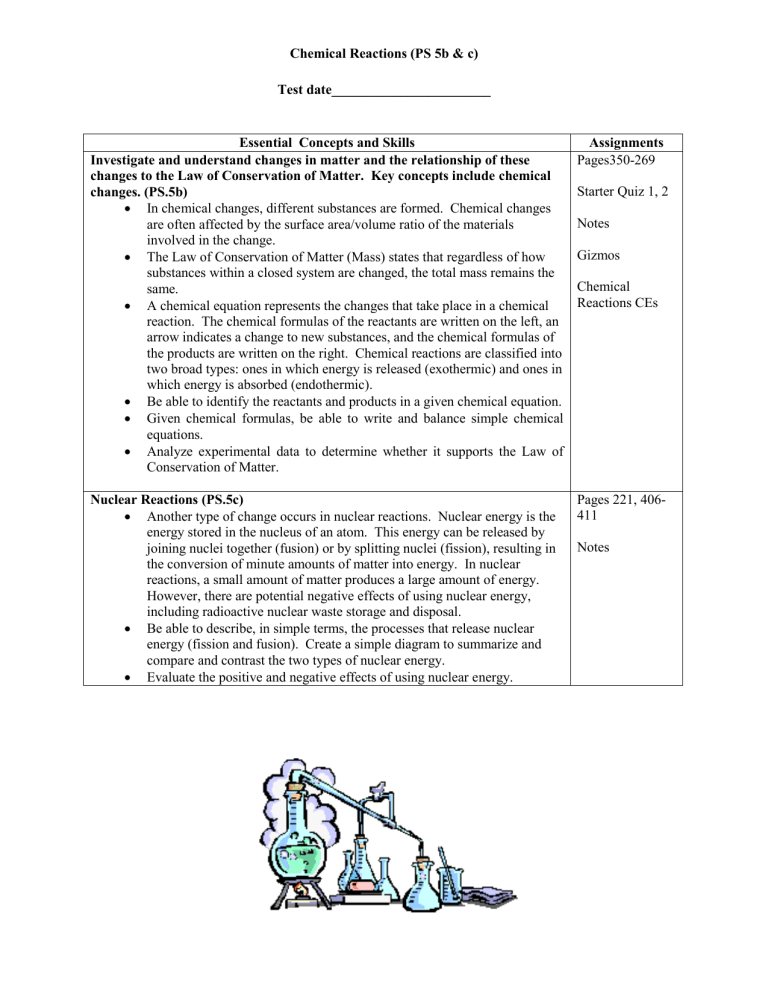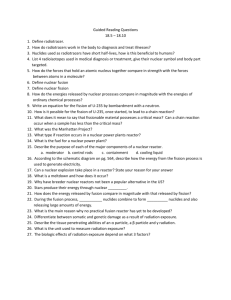Chemical Reactions

Chemical Reactions (PS 5b & c)
Test date_______________________
Essential Concepts and Skills
Investigate and understand changes in matter and the relationship of these changes to the Law of Conservation of Matter. Key concepts include chemical changes. (PS.5b)
In chemical changes, different substances are formed. Chemical changes are often affected by the surface area/volume ratio of the materials involved in the change.
The Law of Conservation of Matter (Mass) states that regardless of how substances within a closed system are changed, the total mass remains the same.
A chemical equation represents the changes that take place in a chemical reaction. The chemical formulas of the reactants are written on the left, an arrow indicates a change to new substances, and the chemical formulas of the products are written on the right. Chemical reactions are classified into two broad types: ones in which energy is released (exothermic) and ones in which energy is absorbed (endothermic).
Be able to identify the reactants and products in a given chemical equation.
Given chemical formulas, be able to write and balance simple chemical equations.
Analyze experimental data to determine whether it supports the Law of
Conservation of Matter.
Nuclear Reactions (PS.5c)
Another type of change occurs in nuclear reactions. Nuclear energy is the energy stored in the nucleus of an atom. This energy can be released by joining nuclei together (fusion) or by splitting nuclei (fission), resulting in the conversion of minute amounts of matter into energy. In nuclear reactions, a small amount of matter produces a large amount of energy.
However, there are potential negative effects of using nuclear energy, including radioactive nuclear waste storage and disposal.
Be able to describe, in simple terms, the processes that release nuclear energy (fission and fusion). Create a simple diagram to summarize and compare and contrast the two types of nuclear energy.
Evaluate the positive and negative effects of using nuclear energy.
Assignments
Pages350-269
Starter Quiz 1, 2
Notes
Gizmos
Chemical
Reactions CEs
Pages 221, 406-
411
Notes
STUDY GUIDE: CHEMICAL REACTIONS
1.
Give an example of a chemical reaction.
2.
Differentiate between a physical and chemical change.
3.
Differentiate between nuclear fission and fusion.
4.
Identify the following reactions as synthesis, decomposition, single replacement or double replacement:
2H
2
O 2H
2
+ O
2
, 2H
2
+ O
2
2H
2
O, AgNO
3
+ NaCl AgCl + NaNO
3
, 2KBr + Cl
2
2KCl + Br
2
5.
List indicators of a chemical change.
6.
Using some of the formulas listed, compose a step-by-step explanation of how to balance chemical equations: HgO, KBr, Hg, O
2
, Cl
2
, Br
2
, KCl.
7.
Differentiate between endothermic and exothermic changes. How would this difference be seen on a graph?
8.
State the Law of Conservation of Mass.
9.
How can reaction rate be increased?
10.
In the reaction 2H
2
+ O
2
2H
2
O , identify the reactants and the product.
11.
Compare the properties of the reactants to the properties of the products.
12.
Balance the equation KClO
3
KCl + O
2
.







